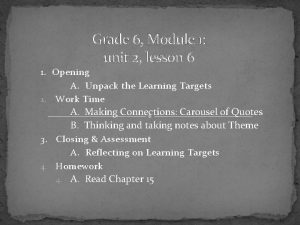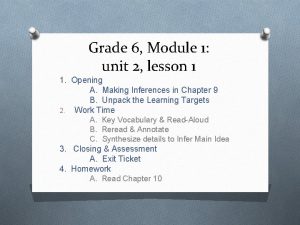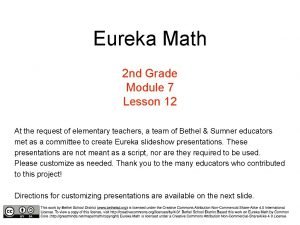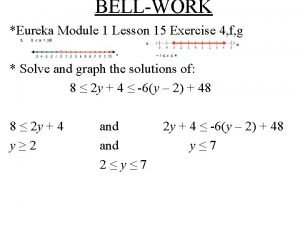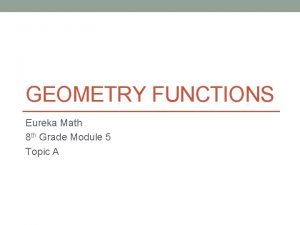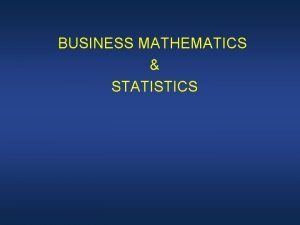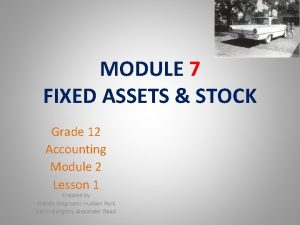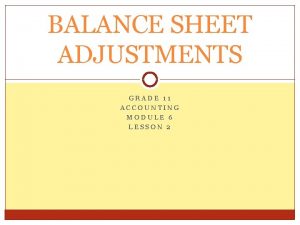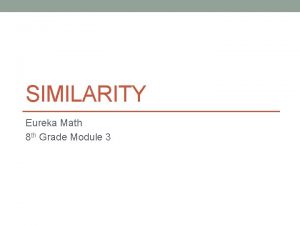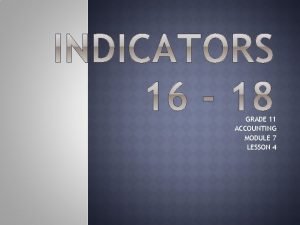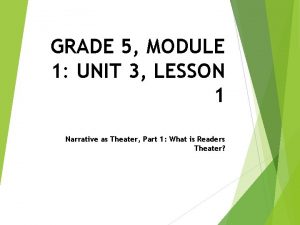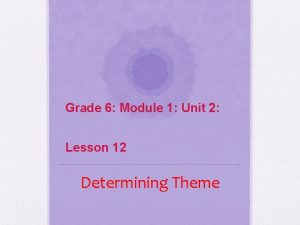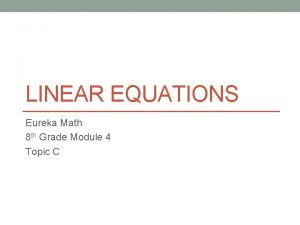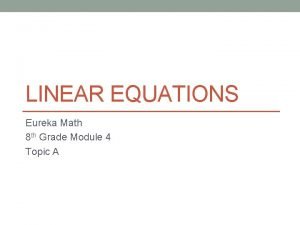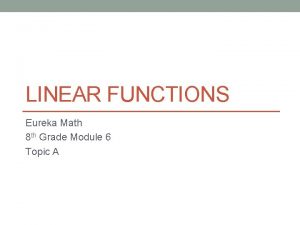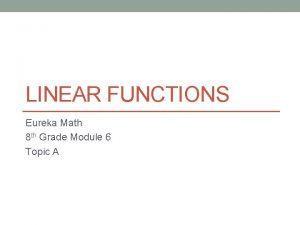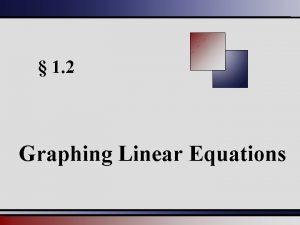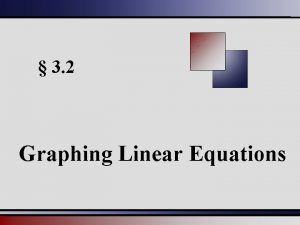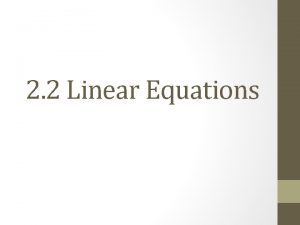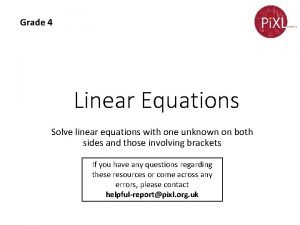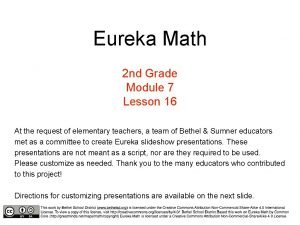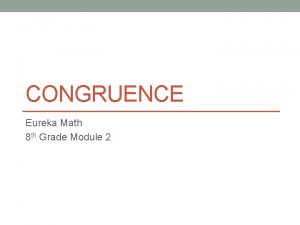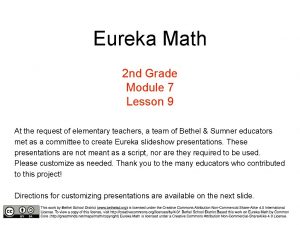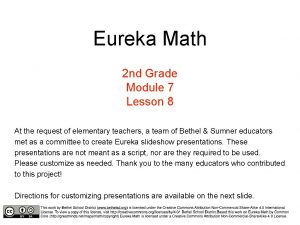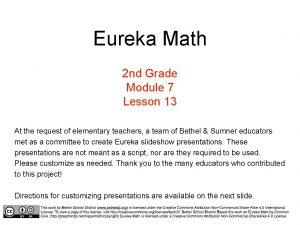LINEAR EQUATIONS Eureka Math 8 th Grade Module

















































- Slides: 49

LINEAR EQUATIONS Eureka Math 8 th Grade Module 4 Topic D

LESSON 24 Opener, Notes, examples(3), workshop

Opener Complete problems 1 -3 in pairs

Notes – Systems of Equations A System of Equations (aka Simultaneous Equations) is a situation when a pair of equations work together. A system can have one solution, no solutions, or infinitely many solutions (just like in lesson 7). The goal is to determine the exact coordinates of the point where the lines intersect. This is a solution to both equations and the solution to the system. { equation 1 Notation: equation 2

Example 1 •


Example 2 •


Workshop Must Do • Lesson 24 cw #4 -5 May Do • Khan academy • PARCC tasks • Linear equation practice • Make up work • Slope practice • Exponents review

Warm Up Rewrite these equations into slope-intercept form (look in lesson 17 for a refresher)

Warm Up Rewrite these equations into standard form (look in lesson 20 for a refresher)

LESSON 25 Workshop, notes

Workshop Must Do • Lesson 25 cw #1 -5 May Do • Khan academy • PARCC tasks • Lesson 25 cw #6 • Finish lesson 24 cw • Linear equation practice • Slope practice • Exponents review

Notes – Systems of Equations A System of Equations (aka Simultaneous Equations) is a situation when a pair of equations work together. A system can have one solution, no solutions, or infinitely many solutions, like in lesson 7. The goal is to determine the exact coordinate (solution) where the two lines intersect. This is also a solution to both equations. { equation 1 Notation: equation 2 Systems of equations typically have ONE SOLUTION because lines intersect at one point. But, • If the lines are parallel (same slope, different y-intercept) they will never intersect NO SOLUTION • If lines are the same (same slope and same y-intercept) they always intersect INFINITE SOLUTIONS

LESSON 26 Review notes, workshop

Notes – Systems of Equations A System of Equations (aka Simultaneous Equations) is a situation when a pair of equations work together. A system can have one solution, no solutions, or infinitely many solutions, like in lesson 7. The goal is to determine the exact coordinate (solution) where the two lines intersect. This is also a solution to both equations. Notation: { equation 1 equation 2 Systems of equations typically have ONE SOLUTION because lines intersect at one point. But, • If the lines are parallel (same slope, different y-intercept) they will never intersect NO SOLUTION • If lines are the same (same slope and same y-intercept) they always intersect INFINITE SOLUTIONS

Workshop Must Do • Lesson 26 cw #1 -9 May Do • Khan academy • PARCC tasks • Lesson 25 cw #6 • Finish lesson 24 cw • Linear equation practice • Slope practice • Exponents review • Make up work

LESSON 27 Notes, examples(3), workshop

Warm Up/Entry Determine the nature of these systems of equations. Do they have one, zero, or infinite solutions?

Notes – Solving Systems of Equations By substitution: 1) Solve one equation so that is says either y= something or x=something (if it already does, you can skip this step) 2) Substitute the entire equation from step 1 into the other equation for that variable 3) Solve for the one variable that remains by: a) Distributing b) Simplifying c) Using properties of equality 4) Substitute back into one equation to find the other.

Example 1 First, does this system have a solution?

Example 2 First, does this system have a solution?

Example 3 First, does this system have a solution?

Workshop Must Do • Lesson 27 cw #1 -6 May Do • Khan academy • PARCC tasks • Finish lesson 24 -26 cw • Linear equation practice • Slope practice • Exponents review • Note sheet • Folder organize

LESSON 28 Warm Up, Notes, examples(3), workshop

Warm Up Explain how you would solve these systems of equations.

Notes – Solving Systems of Equations By substitution: 1) Solve one equation so that is says either y= something or x=something (if it already does, you can skip this step) 2) Substitute the entire equation from step 1 into the other equation for that variable 3) Solve for the one variable that remains by: a) Distributing b) Simplifying c) Using properties of equality 4) Substitute back into one equation to find the other variable. By Elimination: Works best when both equations are in standard form (or can easily be put in standard form) 1) Scale the equations so that the coefficients on one variable will cancel out. 2) Add or subtract the entire equations 3) Solve for the one remaining variable 4) Substitute back into one equation to find the other

Example 1

Example 2

Example 3

Workshop Must Do • Lesson 28 cw #1 -6 May Do • Khan academy • PARCC tasks • Finish lesson 27 cw • Linear equation practice • Slope practice • Exponents review • Note sheet • Folder organize

Warm Up Which method for solving would you use for each system?

Notes/Summary Graphing is, in many ways, the easiest way to solve systems of equations, but the point will only be an estimate. Substitution works best when one already equation has x= or y= or it can easily be written that way. Elimination works best if both equations are in standard form.

LESSON 29 Examples(4), workshop

Example 1 The sum of two numbers is 361, and the difference of the numbers is 173. What are the numbers?

Example 2 There are 356 8 th graders at Euclid Middle School. 34 more than four times the number of girls is equal to half the number of boys. How many boys and how many girls are there?

Example 3 A family member has some five-dollar bills and one-dollar bills in her wallet. Altogether, she has 18 bills and a total of $62. How many of each bill does she have?

Example 4 A friend bought 2 boxes of pencils and 8 notebooks and it cost $11. He went back and bought his brother 3 boxes of pencils and 5 notebooks for $11. 25. How much would 7 notebooks cost?

Workshop Must Do May Do • Exit ticket 27 and 28 • Khan academy • Lesson 29 cw #1 -3 • PARCC tasks • Linear equation practice • Slope practice • Exponents review • Note sheet • Folder organize

LESSON 30 & 31 Notes, Examples, workshop

Celsius & Fahrenheit Two different scales for temperature (American and metric) This led to the formula: F = C + 32 This led to the formula: C = (F – 32)

Examples 1) Change 37°C into degrees Fahrenheit. 2) Change 50°F into degree Celsius

Recall – Pythagorean Theorem

Pythagorean Theorem • So far we have shown with two proofs and much practice that if a triangle is a right triangle, then a 2 + b 2 = c 2 • The converse of this is also true: If a 2 + b 2 = c 2, then a triangle is a right triangle.

Pythagorean Triples Any 3 positive integers that satisfy a 2 + b 2 = c 2 are called Pythagorean Triples. For example: 3, 4, 5 is the most known. It works because 32 + 42 = 52 (9 + 16 = 25) Multiples of Pythagorean Triples also work: 6, 8, 10 is a triple and so is 9, 12, 15, etc. The other “well-known” triple is: 5, 12, 13

Pythagorean Triples You can generate a Triple using the system of equations: { Where s and t are any integers and t > s The solution will always be: And a, b, c will be a Pythagorean Triple.

Example Let s = 1 and t = 2 { {

Workshop Must Do • Lesson 30&31 cw May Do • Khan academy • PARCC tasks • Linear equation practice • Slope practice • Exponents review • Note sheet • Folder organize

The Test Content 1 a: Count slope (15) 1 b: Calculate slope (16) 1 c: understand slope (15 -16) 2 a: Compare rates (11, 24) 2 b: Write equation (1, 2, 11, 24) 2 c: Graph from equation (18) 2 d: Slope from graph (11, 15) 3 a-c: Solve systems (27 -28) 4: Type of solution (7, 25 -26) 5 ab: Type of solution (7, 25 -26) 6 a: write system (29) 6 b: Solve system (27 -29) 7: Equation from points (16) 8 a: Graph from slopeintercept (18) 8 b: Graph from standard (19) 9 ab: Y-intercept (17) 9 c: Write system and equations (18, 24, 29) 9 d: Solution on graph (24 - 25)
 Grade 8 module 1 unit 1 lesson 6 answer key
Grade 8 module 1 unit 1 lesson 6 answer key Eureka math grade 6 module 1 lesson 1
Eureka math grade 6 module 1 lesson 1 Eureka math 3rd grade module 7
Eureka math 3rd grade module 7 Eureka math algebra 1 module 1 lesson 15
Eureka math algebra 1 module 1 lesson 15 Eureka math algebra 1 module 4
Eureka math algebra 1 module 4 Eureka math 9th grade
Eureka math 9th grade Rdw method math
Rdw method math Texas eureka math
Texas eureka math Eureka math pros and cons
Eureka math pros and cons Place value chart eureka math
Place value chart eureka math Is it linear
Is it linear Module 7 solving linear equations
Module 7 solving linear equations Business math module 3
Business math module 3 Persamaan diferensial simultan
Persamaan diferensial simultan Difference between linear and nonlinear equation
Difference between linear and nonlinear equation Metode numerik sistem persamaan linear
Metode numerik sistem persamaan linear C device module module 1
C device module module 1 Eureka npc
Eureka npc Eureka asteroid
Eureka asteroid Eureka, ca seismic station s-p interval = seconds
Eureka, ca seismic station s-p interval = seconds Heuristiko kahulugan
Heuristiko kahulugan Puc pr 2008 para aristoteles em etica a nicomaco
Puc pr 2008 para aristoteles em etica a nicomaco King georges hostel
King georges hostel Elzab eureka
Elzab eureka Isipadu air yang disesarkan
Isipadu air yang disesarkan Eureka eurostars eligibility
Eureka eurostars eligibility Eureka recherche documentaire
Eureka recherche documentaire Eureka, ca seismic station s-p interval = seconds
Eureka, ca seismic station s-p interval = seconds Seretide eureka
Seretide eureka Eureka programa
Eureka programa Bibliotheque uqam
Bibliotheque uqam Eureka
Eureka Huisartsenpraktijk eureka
Huisartsenpraktijk eureka Eurostars-3
Eurostars-3 Aranesp eureka
Aranesp eureka 00102-15 introduction to construction math
00102-15 introduction to construction math Linear module configurator
Linear module configurator Grade 10 english module 4 pre test answer key
Grade 10 english module 4 pre test answer key Principles of marketing grade 12 module 2 answer key
Principles of marketing grade 12 module 2 answer key New era accounting grade 12 memo pdf module 4
New era accounting grade 12 memo pdf module 4 Grade 8 module 1
Grade 8 module 1 Accounting module grade 11
Accounting module grade 11 Grade 8 module 3
Grade 8 module 3 Grade 11 accounting module 1
Grade 11 accounting module 1 Module 1 grade 7
Module 1 grade 7 English module grade 10
English module grade 10 Story of units
Story of units Grade 5 module 1 lesson 1
Grade 5 module 1 lesson 1 Reading and writing module 6
Reading and writing module 6 Grade 6 module 1: unit 2 answer key
Grade 6 module 1: unit 2 answer key
